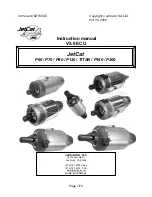
14
Start and adjust the engine as detailed in the starting
instructions.
Now open the throttle fully and run the engine with the
condition of emitting a good deal of white smoke.
Open the needle-valve gradually to increase r.p.m., then
close the needle-valve gradually to lower r.p.m. Repeat this
procedure until two to three full tanks of fuel have been
consumed so that r.p.m. may come close to peak.
Then, proceed IDLE MIXTURE ADJUSTMENT mentioned
in the next page.
Following the initial running-in session, check for any
looseness in the installation due to vibration, then allow the
engine a period of moderately rich operation in flight.
For the first flight, have the needle-valve set on the rich
side and adjust the throttle trim on the transmitter so that
the engine does not stop when the throttle is closed to the
idle setting.
WARNING:
When ground running the engine, avoid dusty or sandy
locations. If dust or grit is drawn into the engine, this
can have a ruinous effect, drastically shortening
engine life in a matter of minutes.
1.
2.
3.
4.
5.
6.
With each successive flight, close the needle-valve very
slightly until, at the end of about 10 flights, the needle is set
for full power. Do not "over-lean" the mixture in an attempt
to extract more power.
If overheating should be suspected at any time during flight
(i.e.if the engine begins to "labor") reduce power by partially
closing the throttle and land the aircraft to enable the
needle-valve to be readjusted to a richer setting.
7.
8.
Once the engine has demonstrated that it can be safely
operated at full power, the carburetor can be adjusted for
optimum throttle response, following the instructions given
in the next section.
Note:
Remember that, when the engine is not yet fully run-in,
the carburetor cannot be expected to give its best
response in flight. Abrupt operation of the throttle, for
example, may cause the engine to stall. Therefore, at this
time ,the aircraft should, as far as is possible, be flown at
an altitude sufficient to enable an emergency landing to
be safely made if the engine stops.
9.
15
Start the engine, open the throttle fully and set the needle-
valve slightly rich (30-45
°
) from the highest r.p.m. setting.
Close the throttle to the idle position. Allow the engine to
idle for about 5 seconds, then reopen the throttle. The
engine should accelerate smoothly back to full speed.
If, instead, the engine responds sluggishly and emits an
excess of white smoke from the exhaust, the idle mixture is
too rich. Turn the mixture control screw approx. 45
°
clockwise to lean the idle mixture.
On the other hand, if the engine hesitates before picking up
speed or even ceases firing completely, the idle mixture is
likely to be too lean. Turn the mixture control valve 90
°
counter-clockwise to substantially enrich the mixture, then
back again 45
°
clockwise.
IDLE MIXTURE ADJUSTMENT
In paragraphs 3 and 4 above, the 45
°
total movements are,
of course, approximate. It will be necessary to fine-tune the
mixture control screw 10-15
°
at a time to reach the best
setting for optimum throttle response.
Continue re-checking the idle mixture setting until the
engine responds smoothly and positively to operation of
the throttle at all times.
1.
2.
3.
4.
5.
6.
CARE & MAINTENANCE (laying up)
The fuel pump assembly,
carburetor/pressure-regulator and
silicone tubing must be cleansed
separately in methanol or glow
fuel. On no account must they
come into contact with kerosene.
Before completely reassembling
the engine, make sure that no
kerosene remains inside that could
find its way into the pump unit,
carburetor, etc. Inject, sparingly,
preserving oils, rust inhibitors, etc.
unless approved for silicone-rubber
products.
An appropriate alternative here
may be one of the high-quality
synthetic lubricating oils.
Finally, seal the engine in a heavy
polyethylene bag until required for
reinstalling in the airframe.
Debris tends to
accumulate in
this area
NOTE:
The use of a different fuel, particularly one containing
more, or less, nitromethane and/or a different type or
proportion of lubricating oil, is likely to call for some
readjustment of the Needle-Valve.
Remember that, as a safety measure, it is advisable to
increase the Needle-Valve opening by an extra half-turn
counter-clockwise, prior to establishing a new setting. A
different silencer may alter the exhaust pressure applied
to the fuel feed and call for a revised Needle-Valve
setting. The use of a different glowplug may also reguire
compensating carburetor readjustments.
































